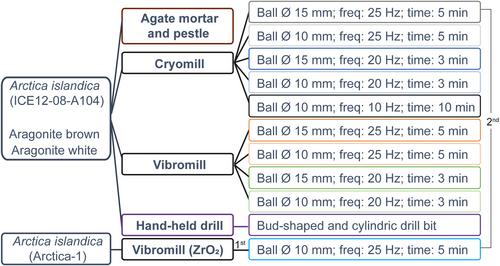Stable carbon and oxygen isotope data of biogenic and abiogenic aragonite are of fundamental relevance in paleoclimate research. Wet-chemical analysis of such materials requires well-homogenized, fine-grained powder. In the present study, the effect of different grinding/milling methods on sample homogeneity and the potential risk of unintentional calcite formation and isotope shift were evaluated.
Shells of Arctica islandica and aragonite sputnik crystals were pulverized using a set of commonly used methods, including a hand-held drill, a vibromill operated at various settings (with and without liquid nitrogen cooling, changes in ball diameters, frequencies, and processing durations), and an agate mortar and pestle. Stable isotope values were measured using an isotope ratio mass spectrometer operated in continuous flow mode. Identification of mineral phases was obtained by powder X-ray diffraction (PXRD), Raman spectroscopy, and attenuated total reflectance-Fourier transform infrared (ATR-FTIR) spectroscopy. Calcite content was quantified by PXRD Rietveld refinement.
Samples showed substantial homogeneity, in particular after vibromilling (duration 3–10 min). More vigorous grinding resulted in larger fractions of calcite (0.5–4.2 wt%) and a concomitant δ18O and δ13C decrease, specifically in bivalve shells. The only method for producing pure aragonite powder was by pounding the aragonite sputniks manually with an agate mortar and pestle.
None of the studied, commonly used machine-based pulverization methods produced pure aragonite powder from samples consisting originally of aragonite. These findings have significant implications for light-stable isotope-based paleoclimate reconstructions. Except for abiogenic aragonite powder produced by pounding in an agate mortar, paleotemperatures would be overestimated.


